Hiking boots are probably the best footwear for the trail. Considering how important footwear is on the trail, hiking boots are highly functional and meet most foot needs on the trail.
You can wear hiking boots on different terrains, for short or long hikes, or during different weather conditions, and you will be good. In addition, hiking experts advise that people wear hiking boots on the trail.
But what happens if you don’t have a pair? Should you stay home and do other stuff, or are there other alternatives? Sure, hiking boots are good, perhaps the best for certain trails and hiking situations, but they are not cheap, and some people cannot afford them.
While you have the option of buying used hiking boots, they may not be the best choice, and sometimes, they may still be unaffordable. What should you do then?
There are other footwear options available that you can use on the trail. Rather than staying at home when you would rather be on the trail, you can use other shoes available at home.
This article will discuss other shoes that you can wear on the trail that can function to a reasonable extent.
Let’s get right into it!
Contents
What Should I Wear If I Don’t Have Hiking Boots?

Hiking boots are not the only shoes you can wear on the trail. While they are probably your best option, you can’t really do much when they are unavailable.
The next thing to do would be to wear the available shoes. However, this does not mean you can wear just any shoes because they have to fit the activity.
For example, your heels or flip-flops won’t do you any good on the trail, and your hike could end in disaster. When choosing what other shoes to wear, the important things are that they should fit appropriately, protect your feet, be comfortable, and be lightweight.
When your shoes are checked, you can wear them on the trail. Another thing is that they have to suit the hiking situation, terrain, and weather.
With that said, what kind of shoes can you wear on the trail if you don’t have hiking boots? You can try the following options:
1. Hiking Shoes
- Pigskin leather and mesh upper
- Traditional lace closure
- Bellows tongue keeps out debris
Last update on 2023-11-11 / Affiliate links / Images from Amazon Product Advertising API
If you don’t have hiking boots, hiking shoes are the next best option you can wear on the trail. Basically, hiking shoes are meant for the trail, and their manufacturers designed them for this specific purpose.
They are very similar to hiking boots, and they share many beneficial features. Just like boots, hiking shoes are protective and supportive on the trail. Some hikers prefer them to hiking boots because they are more comfortable and lightweight.
Wearing hiking shoes on the trail is good. First, most technologies and features found in hiking boots are also available in shoes. For example, they provide adequate traction on the trail.

They have grippy soles that ensure your steps are solid on the terrain, whether it be plain, rough, rocky, or slippery. That is, you can use them on different terrains.
They are also breathable, so you can rest assured that you will be able to maintain dry feet on the trail. In addition, they are waterproof to an extent because of waterproof technologies used in them, like gore-tex, for example.
However, they are not as waterproof as hiking boots. They provide support for your feet on the trail and make hiking easier.
They are also lightweight and super comfortable on the trail. If all you have are hiking shoes for hiking, you are good to go for a long period of time because they can last a great deal, but not as hiking boots.
Lastly, you can use them in different weather and terrains.
Pros
- They are lightweight.
- Comfortable and convenient to use.
- Great traction
- Good for different terrains and weather
- They are durable.
- Don’t require breaking in.
- More breathable than hiking boots.
Cons
- Don’t support the ankle enough.
- Not as durable as hiking boots.
- They are not highly waterproof.
2. Trail runners
- A wide toe box lets your toes spread and relax.
- Produced using animal free products and processes.
- Removable sockliner (insole) if you want a “more barefoot” feeling.
Last update on 2023-11-11 / Affiliate links / Images from Amazon Product Advertising API
Trail runners are another type of hiking shoe.If you have a pair of trail runners that you use often or once in a while, you can also use them for hiking.
They are also good for hiking trails. However, where you use them matters. How can trail runners benefit you on the trail? First, trail runners ensure traction on the trail. They have lugged soles that are grippy and ensure firm stances on mud, gravel, rock, and dirt.
Therefore, they are suitable for different terrains. Another thing about trail runners is that they ensure foot protection due to their features that protect the feet from impacts on the trail.
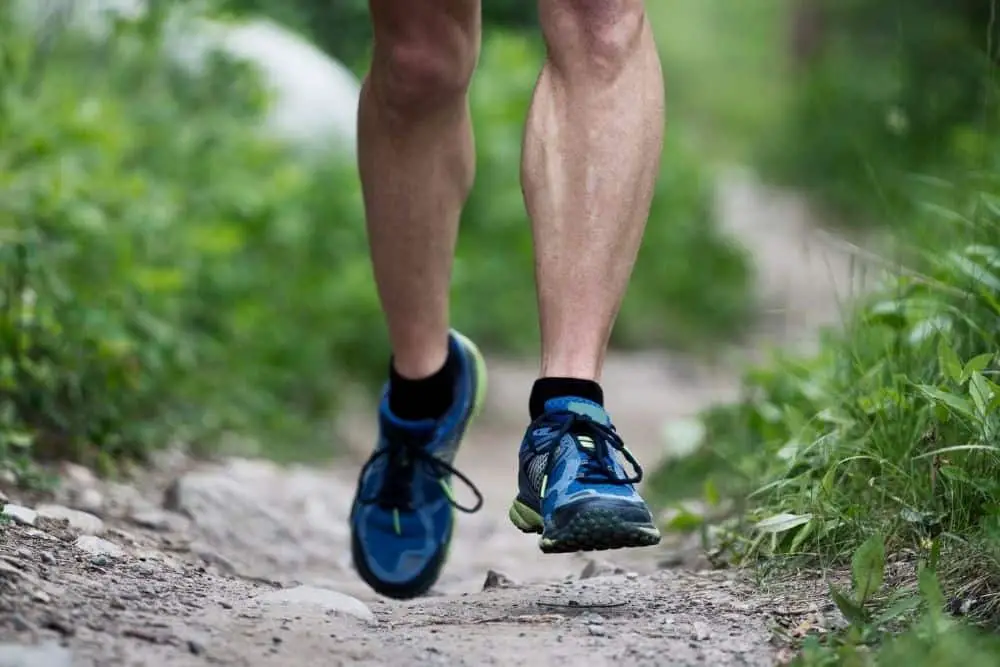
They have durable upper materials that can withstand different elements. In addition, they support the feet to an extent thanks to their stiff construction, which helps to keep the feet in place and prevent foot rotation.
Furthermore, trial runners are very comfortable, and they have cushioning, which varies depending on what type they are. They are also highly breathable, so they can prevent your feet from retaining moisture.
This makes them suitable for hiking during hot weather. They are lightweight and comfortable, so they require little or no breaking in at all. It is a big plus if your trail runners are waterproof, so you can use them on wet terrain or during light rain showers.
Pros
- They are comfortable.
- Lightweight and not heavy on the feet.
- Suitable for hot weather.
- They are breathable.
- Doesn’t require much break-in effort or none.
- Offers good traction.
Cons
- Not so durable and requires changing often.
- Less supportive.
- Can’t completely keep moisture out.
3. Sneakers
- DURABLE AND LIGHTWEIGHT MATERIAL: These sneakers feature soft leather upper that is supportive and...
- EFFICIENT FOOT SUPPORT: These athletic trainers with die-cut EVA midsole provides support which...
- REMOVABLE ORTHOTICS INSERT: This footwear with Ortholite foam sockliner is suitable for orthotics...
Last update on 2023-11-11 / Affiliate links / Images from Amazon Product Advertising API
Have you got your favorite pair of sneakers yet? Then, you can wear them for a hike on the trail. Your sneakers are not totally useless on the trail, and they can be your next alternative if you don’t have hiking shoes or trail runners.
Wearing sneakers will probably be a good choice, especially if you don’t intend to hike for a long period of time and it is just a one-time thing. You probably don’t want to spend a lot on a pair of hiking boots that you probably won’t use after hiking once.
Although you cannot compare sneakers to hiking shoes or boots, especially when you consider what you intend to use them for, they are not totally useless. Your sneakers will suffice if you only hike a short distance or on easy or plain terrain.

You can wear sneakers if you are hiking on nature trails or plain terrain. They won’t keep you safe if you wear them through streams of water, hike up or down a slope, or walk on rock or uneven terrain.
They are not built for that. Sneakers are supportive; they have elevated soles and ensure balance to an extent. In addition, they are comfortable and don’t require break-in time, especially if you have been wearing them for a while.
Sneakers are not good for aggressive hikes, and they would probably put you in danger because they don’t provide ankle support, water resistance, and traction. And all of these things are important for safety.
Therefore, if sneakers are all you have, you should only wear them while hiking on short and easy hikes and during cool or hot weather. You are better off not hiking than wearing sneakers on slippery, tough, rough, and uneasy terrain.
Pros
- Good for short and easy hikes.
- Comfortable use.
- Don’t require breaking in.
Cons
- Lack ankle support.
- Not enough traction.
- Unfit for rough terrains and intense hikes.
- Low traction.
- Not so durable.
4. Running shoes
- Lightweight mesh upper with 3-color digital print delivers complete breathability
- Durable leather overlays for stability & that locks in your midfoot
- EVA sockliner provides soft, step-in comfort
Last update on 2023-11-11 / Affiliate links / Images from Amazon Product Advertising API
Another kind of shoe you can wear for hiking if you don’t have hiking boots are running shoes. In this case, road running shoes are preferred, not trail runners. While road running shoes are not as fit as tail runners for hiking, they are not a completely bad idea.
Running shoes ensure adequate grip on the trail, but nothing as spectacular as hiking boots. Sure, they have soles, but they offer less grip and traction on the trail.
Therefore, they may be unfit for slippery terrain, but you are good with easy, dry, and plain ones. Their soles can fade with use, so you should definitely steer clear of rough terrain.
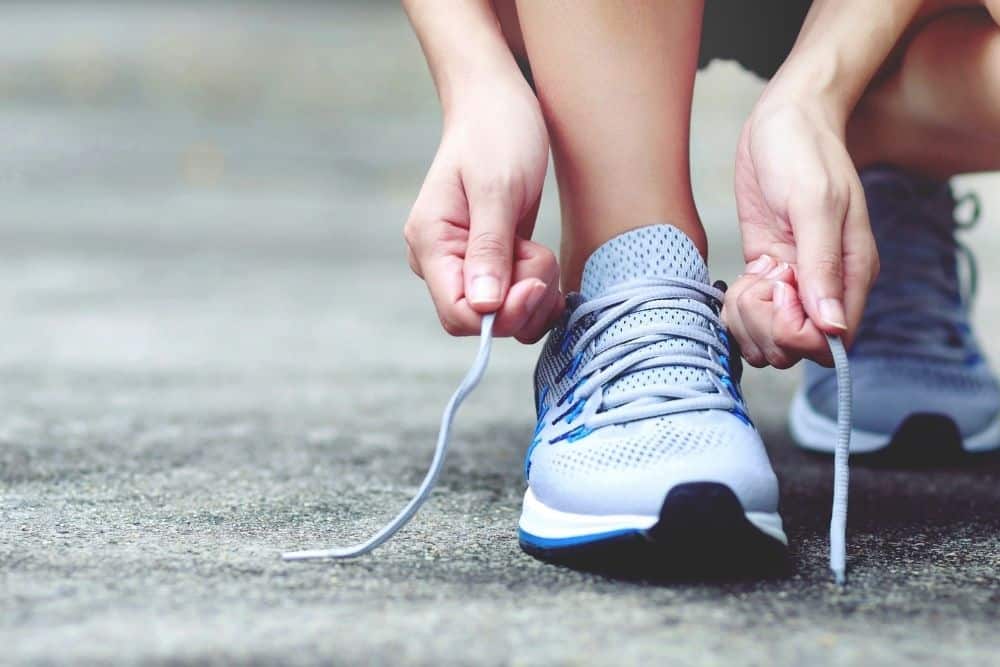
They also ensure little toe protection, which may be unsuitable for rough or rocky terrain where you need adequate toe protection. But the good thing is that they are very breathable with their mesh uppers, so you can use them during hot or cool weather.
This will also help to ensure to an extent that your feet and socks stay dry. However, they are not waterproof, so you can use them on wet terrains or during rain. They also don’t have high tops that can help with ankle support.
Therefore, running shoes are most suitable for easy walks on nature trails and during hot weather.
Pros
- Lightweight for the trail.
- Comfortable for use.
- Breathable and keep feet dry.
Cons
- Not durable.
- Lack ankle support and adequate traction.
- Not waterproof.
- They are not suitable for tough hikes or cold weather.
- Low traction.
5. Cross trainers
- Men's leather sneakers: leather upper features overlays for support and perforations for airflow
- Comfortable training: foam Phylon midsole and full-length encapsulated Air-Sole unit cushions for...
- Natural motion: solid rubber outsole is durable and provides traction over varied surfaces
Last update on 2023-11-11 / Affiliate links / Images from Amazon Product Advertising API
If you are a fitness person and you have a pair of cross-training shoes you use at the gym, you can wear them while hiking if you don’t have hiking boots. The shoes can do more than training shoes, especially if you don’t plan to hike often.
Cross trainers are more beneficial for hiking than walking shoes. They ensure comfort, support, and stability on the trail. First, they provide heel support for you on the trail due to their heel feature.
They have EVA foam and polyurethane layers, which not only provide support but also comfort. They also have thick outsoles that provide stability and traction on the trail.
In addition, they have supportive midsoles that can be beneficial on the trail. They are also breathable and flexible. Also, their soles are thick, which makes them absorb shock from hard hits.
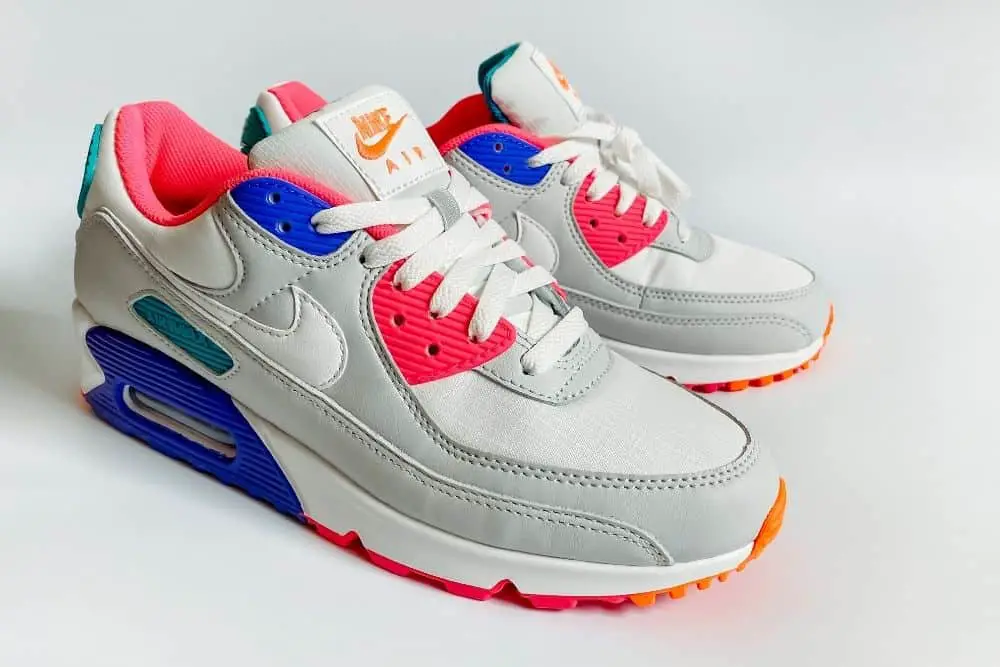
However, most of these buildings are majorly for cross-training, but they can work on the trail. Therefore, you can wear them on short-distance hikes and easy terrain for your safety on the trail.
The good thing is that they ensure adequate support on the trail, which you need, so they are not entirely bad.
Pros
- Provide adequate support.
- Have noticeable traction.
- They are flexible and breathable.
- Comfortable for use on the trail.
- Good for short and easy hikes.
Cons
- Not waterproof for the trail.
- Inadequate ankle support.
- Unsuitable for all hiking situations or terrains.
6. Hiking sandals
- WATER-RESISTANT: Quick dry washable synthetic straps and lining for active use in and out of the...
- SUPPORT & COMFORT: Lace lock bungee capture system provides a secure fit while offering quick and...
- TRACTION & PROTECTION: Multi directional lugs with siping channels provide superior grip on slippery...
Last update on 2023-11-11 / Affiliate links / Images from Amazon Product Advertising API
Hiking sandals are one of the lightest footwear options you can wear while hiking, and they are part of the hiking trend. If you have them, then you can wear them on the trail, and they can make hiking awesome or unpleasant, depending on when you wear them.
One of the good things about hiking sandals is that you can do away with all the stiffness and rigidity that hiking boots provide. With all the coverings out of the way, you can enjoy hiking with fewer blisters, making the experience more enjoyable for you.
They don’t have much contact with your feet, so the sweat and stickiness can be out of the way. With that out of the way, your feet can enjoy a cooler breeze on the trail and feel better.
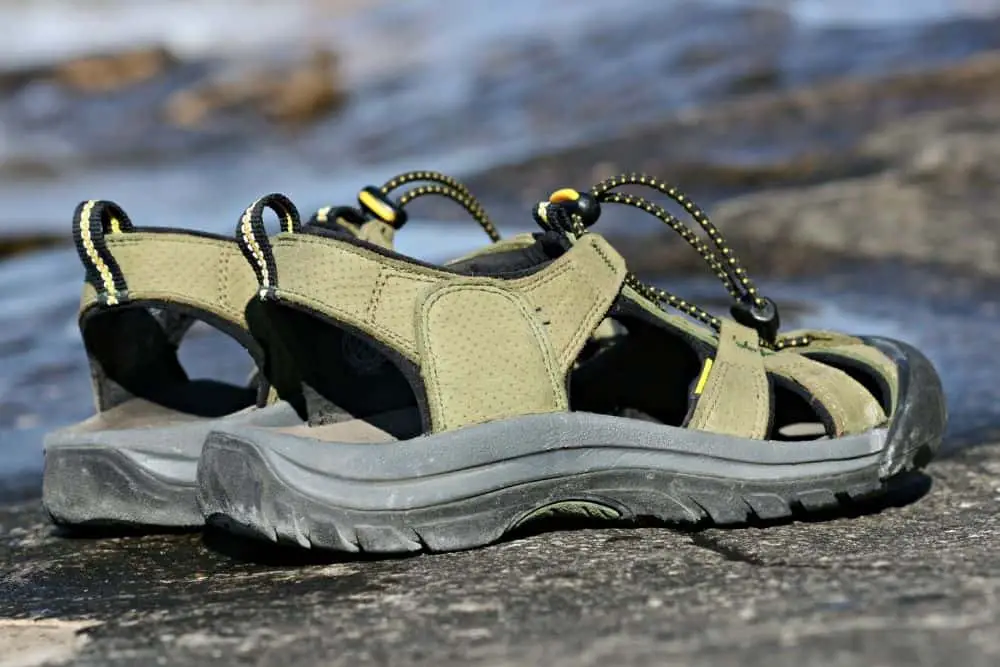
Instead of being waterproof, hiking sandals are water-safe and good for water. You can walk through water to cool your feet without getting your feet wet.
That way, you don’t have to deal with blisters, fungal infections, or discomfort. You can wear them on short or long hikes on easy terrain.
Since they are not so protective or supportive, they may be unsuitable for rough or rocky terrain and can make your feet hurt. In addition, they lack adequate traction, so they are not so grippy on slippery terrain.
They are also better for hiking during hot weather and very unsuitable for cold weather, rain, or snow.
Pros
- Very comfortable.
- They are flexible.
- Fewer blisters on the trail.
- Cool feet.
- Lightweight footwear.
- Better foot health.
- Durable for use.
Cons
- Straps can cause hotspots
- Exposes feet to cold.
- Inadequate traction
- No ankle support.
- Exposes feet to sunburn, sharp objects, snake bites, and more.
7. Tennis shoes
- Tennis-inspired shoes with pillow-soft cushioning for everyday wear
- Regular fit; Lace closure
- Synthetic leather upper for durability
Last update on 2023-11-11 / Affiliate links / Images from Amazon Product Advertising API
Tennis shoes are for the sport and are mainly used on court surfaces, and they have been built that way. However, if your hiking boots are not available and they are all you have got as shoes, you can wear them while hiking.
They don’t exactly have the same features as hiking boots, but they do have features that can serve you well on the trail. On the other hand, tennis shoes don’t have supportive uppers, lugged soles, and all those features.
However, they have cushioning that can make you feel comfortable on the trail. They are also lightweight and not extra weight on your feet, making hiking easy.
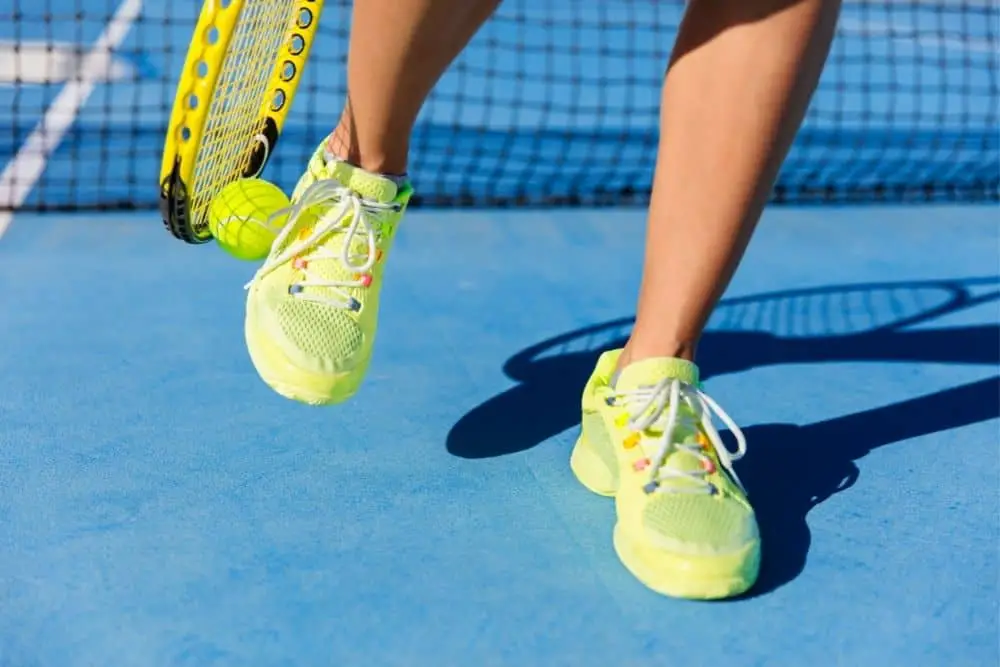
In addition, they have ventilation holes and breathable materials, which makes them good for hot weather, but this affects their waterproofness. While they may sometimes have heel and toe traction, they are not exactly strong enough for some hiking trails.
You should hike in tennis shoes if you are going on a laid-back or relaxing short hike. They are also good on easy hiking terrain.
However, they are not as effective and efficient as hiking boots.
Pros
- They are lightweight.
- Comfortable and convenient for short hikes.
- Good for easy hike trails.
- They are versatile.
Cons
- Lack of adequate traction.
- No ankle support.
- Inadequate cushioning.
- Not durable for prolonged use on the trail.
- Not waterproof.
8. Approach shoes
- GORE-TEX Upper - Durable waterproof protection to the upper.
- Breathable - Moisture and air within the shoe is able to escape for breathability.
- Suede Leather - Robust material will improve the structure and keep the feet protected.
Last update on 2023-11-11 / Affiliate links / Images from Amazon Product Advertising API
Another shoe you can wear while hiking if you don’t have hiking boots are approach shoes. Approach shoes are common and are mostly used by rock climbers to climb mountains.
Some people use them for activities other than rock climbing, like hiking. Therefore, if you have shoes in your shoe compartment, then you can wear them on the trail.
First, they have grippy soles that can help a lot on different hiking terrains. That means you can use approach shoes on plain, easy, rocky, or slippery terrains.
This is because they have similar soles to hiking shoes. This helps to ensure stability on the trail. Depending on whether they have waterproof lining and features or not, they can be waterproof and protect your feet from moisture.
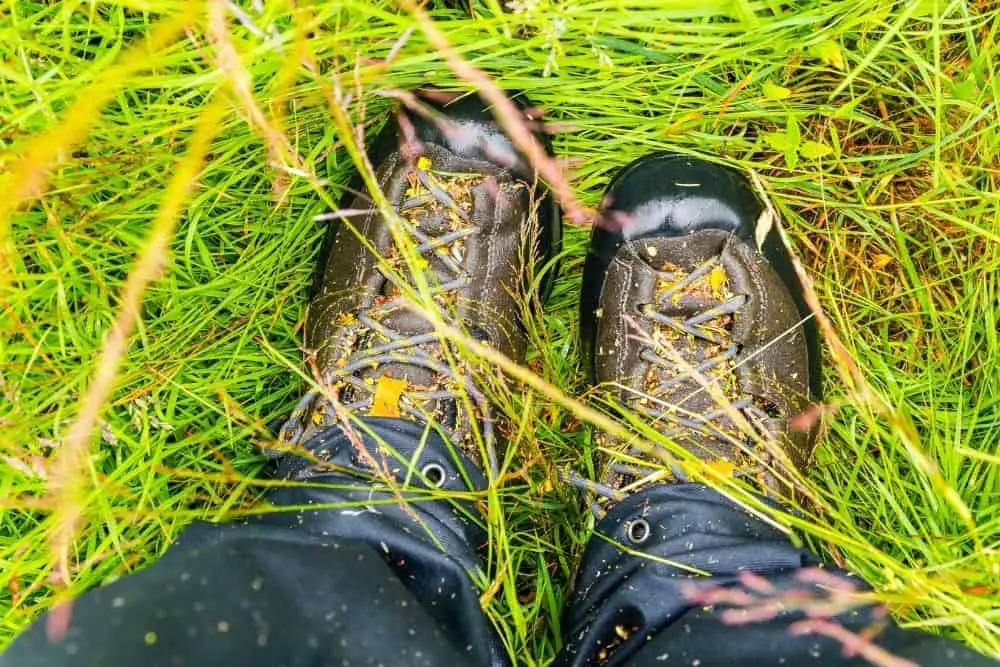
In addition, they are stiff and provide support for your feet on the trail. Also, they provide good traction because they have a softer rubber compound, enabling more friction between the shoes and rock or terrain, ensuring a better cling-on factor.
One downside to them is that they lack insulation and don’t provide enough warmth for hiking during winter. Furthermore, because of their soft rubber compounds, they do not last as long as hiking boots.
But generally, they are good for hiking on different terrains, including rough and easy ones.
Pros
- Suitable for hiking.
- Ensures adequate traction.
- They are supportive.
- Good for different hiking terrains.
- Can be waterproof.
Cons
- They are stiff.
- Not as comfortable as other footwear.
- Lacks insulation for cold weather.
- Not so durable.
Conclusion
Hiking boots are not always available, and not everyone has or can afford a pair. This, however, should not hinder you from hiking if you enjoy hiking or have a hiking trip planned.
Instead of buying, borrowing, or not going at all, you can improvise with other shoes. It could be that they are available for use or are inexpensive to get for immediate use.
We have listed some of the shoes you can wear in place of hiking boots. The most important thing is that you are comfortable wearing them and you don’t use them for hiking terrain and weather that they are unfit for.
For example, if all you have is a pair of sneakers, then you know you can only wear them for short hikes on plain terrains and during hot or cool weather. You should apply this to other shoes you eventually decide to wear.
Have fun on the trail!









